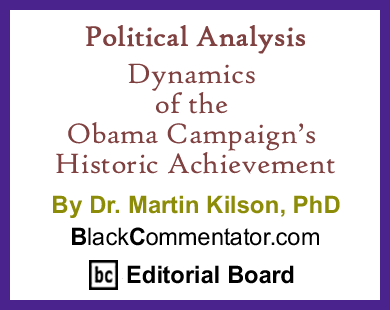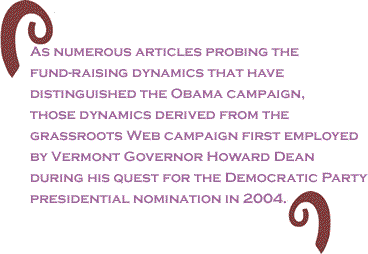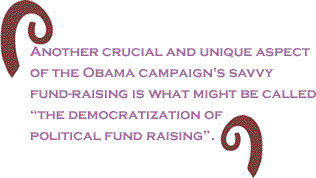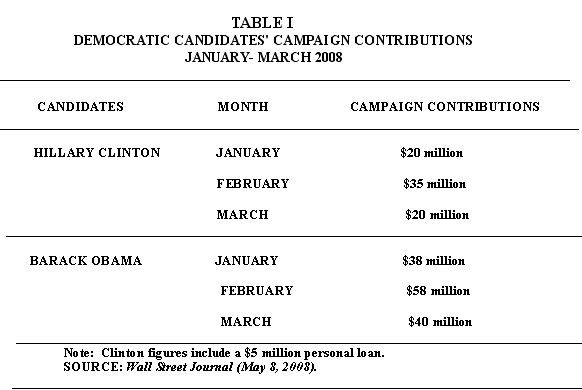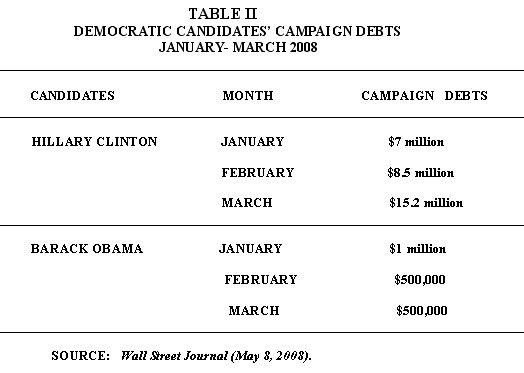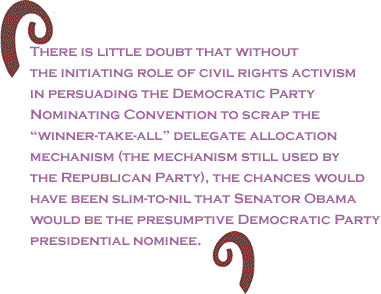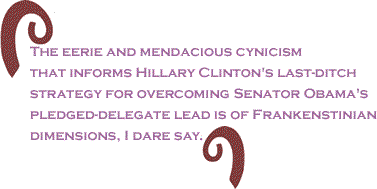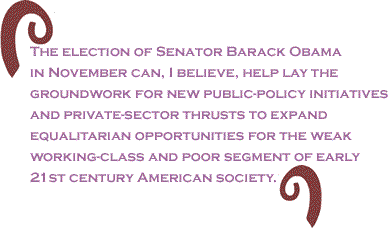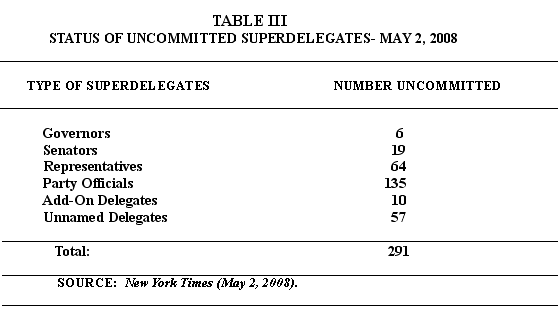
|
||||||||||||||||||||||
 |
||||||||||||||||||||||
 |
||||||||||||||||||||||
 |
||||||||||||||||||||||
 |
||||||||||||||||||||||
 |
||||||||||||||||||||||
 |
| The current issue is always free to everyone |
|
|
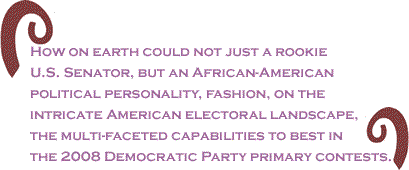 |
Prologue This is my seventh probe in real time of the course of Senator Barack Obama's campaign for the Democratic Party presidential nomination. In this article (which I'm writing between May 20th and May 22nd), I want appraise key attributes of the Obama campaign and how they contributed to the historic achievement of the first African-American to gain a major political party's presidential nomination. I conclude the article with a critique of the Clinton campaign's cynical and tawdry race-card maneuvers that have sought to prevent the Obama campaign's historic achievement. Now that the May 20th Kentucky and Oregon primaries have been completed (Clinton winning the former, Obama the latter) and only three primaries remain (Puerto Rico- June 1, South Dakota-Montana- June 30, it is certain that whatever the outcome of those primaries Senator Barack Obama of Illinois will gain the Democratic Party nomination in August. Interestingly enough, two days after Senator Hillary Clinton's victory by 9-percentage points in April 22nd Pennsylvania primary the Wall Street Journal columnist, Daniel Henninger, had decided that the predominate media appraisal that the Pennsylvania victory revived Clinton's chances to win the Democratic nomination was mistaken. Instead, Henninger presented an alternative and prescient prognosis—that the Democratic nomination would go to Senator Obama.
It was also in the pages of the Wall Street Journal—its lead editorial no less—that the earliest prediction by a major newspaper that Senator Obama would be the Democratic nominee was offered. This occurred way back in the Wall Street Journal (February 13, 2008), following Obama's victory in the February 5th Super Tuesday 22-state primaries, and a week later in the February 12th so -called Potomac primary (Maryland-Virginia-Washington, D.C.). The editors of that great capitalist newspaper conjured something at this mid-point in the 2008 primary tea leaves that other media conjurers missed and didn't hesitate to hazard a broader meaning. To wit:
How did this Wall Street Journal prognosis become reality? How on earth could not just a rookie U.S. Senator, but an African-American political personality, fashion, on the intricate American electoral landscape, the multi-faceted capabilities to best in the 2008 Democratic Party primary contests - what the Wall Street Journal aptly dubbed “the most successful Democratic machine [the Clinton Machine] of the last generation”? Valerie Jarrett: Engineer Of Obama Campaign Future historians of the 2008 primary contests will no doubt identify Valerie Jarrett as an important factor in the Obama campaign's historic achievement—in fact, as the engineer of the Obama campaign. In an Wall Street Journal (May 12, 2008) article that scooped other major newspapers, the country was informed of the virtually unknown political personality of Valerie Jarrett, whom the newspaper called “an essential member of [the Obama campaign's] inner set”. She was also identified as “Obama's brain trust...that Barack Obama says he doesn't make a major decision without consulting adviser Valerie Jarrett.” The article continued:
One week after the Wall Street Journal article on Valerie Jarrett, Newsweek Magazine (May 19, 2008) added to our knowledge of her relationship to Senator Obama. “When he wanted to run for the U.S. Senate,” reports Newsweek, “he first had to convince Michelle and Jarrett that it was a good idea. He's been seeking her counsel ever since.”
It might be said that there's little that's ordinary about Valerie Jarrett as an “inner set” adviser to the presidential nominee of a major political party. The Wall Street Journal article that first informed the country of Jarrett's existence had comparative references to Burt Lance who was a key adviser in Carter's campaign and Karen Hughes who was a key adviser to George W. Bush, but their resumes were, one might say, culturally, professionally, and politically slim compared to Jarrett's. Why do I say this? First, culturally Jarrett is an African-American, a fact containing-in-itself unique American life defining dimensions. She's the daughter of a medical scientist—a pathologist—who was the first African-American full-professor in the Department of Biological Sciences at University of Chicago, and the daughter too of a psychologist who was the president of the Erickson Institute, a Graduate School and Research Center in Child Psychology at the University of Chicago that was named after the famous development psychologist Eric Erickson. Also, Jarrett's grandfather was the first African-American to direct a major city bureaucracy in the United States—the Chicago Housing Authority during the 1940s. Jarrett, now 51 years old, gained her law degree from the University of Michigan Law School. Like others among her generation-cohort of 20th century African-American professionals (the fifth-generation cohort), Jarrett and her Black professional peers benefited from the existence of numerous Black Mayors through whom they could gain significant experience in the public policy arena—a situation not available to previous generations of Black professionals. As Newsweek Magazine (May 19, 2008) informs us, Valerie Jarrett “got her start [in public policy arena] working for Harold Washington, the city's first black mayor.” And Jarrett's initial experience in the public policy arena was substantive and significant, as the Wall Street Journal (May 12, 2008) relates:
Particularly interesting about Valerie Jarrett's public policy career since its debut in the late 1970s-and early-1980s Harold Washington Chicago Mayoralty, has been a persistent intertwining of Jarrett's policy function with African-American realities. As the Wall Street Journal (May 12, 2008) reports: “...Most Recently, as a board member of the committee to bring the 2016 Summer Olympics to Chicago, she has forged cooperation between corporate leaders and the African-American community on the South Side, where most of the sporting and residential venues could be built.” Furthermore, following Senator Obama's powerful rallying address to the 2004 Democratic Party National Convention when a degree of political tension surfaced between him and the influential Chicago civil rights leader Rev. Jesse Jackson, Valerie Jarrett joined another Black professional in her generation-cohort (John Rogers, an African-American finance manager who heads Ariel Investments which manages a $7 billion fund) to negotiate successfully between the two potent personalities.
In 1995 following the publication of Senator Obama's autobiography Dreams From My Father, Jarrett gave up some 20-odd years working in the public policy arena to work for Habitat Co., a major real-estate developer in Chicago of which she became CEO. The connections she developed at the top ranks of the Chicago business community proved crucial to Jarrett when she embarked upon her first major political role. That role was serving as chair of the finance committee of Barack Obama's victorious campaign for the U.S. Senate in 2004. But this was not Jarrett’s first interaction with Obama. That occurred in 1991, an event related vividly in the Wall Street Journal (May 12, 2008):
Although Valerie Jarrett is typically introduced “as one of the most powerful women in Chicago”--to quote the Wall Street Journal (May 12, 2008)-- when she enters the trenches of the day-to-day Obama campaign to interact with the “driver ants”, so to speak, Jarrett exhibits not her “power-self” but her “deep-compassionate self”. As the Wall Street Journal puts it:
When asked recently about her future role in a possible Obama presidential administration, Valerie Jarrett remarked: “I'm not thinking about that now”, she said. “We're just taking care of what's in front of us”. (Wall Street Journal (May 12, 2008)). What lies in front of Jarrett and the Obama campaign is a quest to heal-and-revitalize an American democracy that the Republican Party, its power-class and corporate minions, have rendered operationally decrepit. To heal-and-revitalize an American democracy that's out-of-sink with the massive needs of 21st century American citizens. Owing in no small part to Valerie Jarrett, American citizens will have the unique opportunity in November 2008 to elect an African-American as president— a president who is fully capable of leading our country on a path of major democratic revitalization. That the Obama campaign's achievement to date has been engineered by an African-American female professional reflects, I should add, a larger transformation of the overall status of women within the African-American intelligentsia.
In my article for Black Commentator (September 27, 2007) titled “The Role of the Black Elite in Outreaching to the Black Lower Class”, I reflected on the new Black female white-collar employment status as follows:
That Valerie Jarrett has been the engineer of the 2008 Obama campaign for the Democratic Party presidential nomination is, I suggest, an unmistakable instance of “liberal African-American impacts upon American society” here in the early 21st century. Senator Barack Obama's election as president in November will, it is hoped, facilitate the broadening of numerous revitalization advances in the depth, range, and quality of life-chances of American citizens in general and the life-chances of African-Americans in particular. Obama Campaign's Fund Raising Achievement:(I) Gaining Lots Of Money The issue of Time Magazine (May 19, 2008), not only had Senator Barack Obama on its cover but it also contained two leading articles which identified several key ingredients of Obama's pending nomination as the Democratic Party's presidential candidate at its August convention. In the first leading article titled “The Game Changer”, the columnist Joe Klein observed that “Barack Obama has refused to play by the old political rules. He's about to be rewarded for it.” One of the “old political rules” related to how major campaign funds are raised for the tasks associated with a major political party's primary contests.
In the second article titled “The Mistakes She [Hillary Clinton] Made”, five such mistakes are delineated: “She Misjudged The [National] Mood”; “She Didn't Master The Rules”; “She Underestimated The Caucus States”; “She Relied On Old Money”; and “She Never Counted On A Long Haul”. Elaborating the significance of mistake No. 4, the articles author—Karen Tumulty--observed, “For a decade or more, the Clintons set the standard for political fund-raising in the Democratic Party.... Her donors were typically big-check writers. But something had happened to fund-raising that Team Clinton didn't fully grasp: the Internet.” On the other hand, Barack Obama embraced the Internet. As Tumulty puts it:
Another perceptive characterization of what has differentiated the Obama campaign from the “play-it-by-old-political-rules” Clinton campaign was provided in a data-rich article in the Wall Street Journal (May 8, 2008). Like the articles in Time Magazine (May 19, 2008), the Wall Street Journal article singled-out the fund-raising dynamics as crucial in defining the two campaigns.
As numerous articles probing the fund-raising dynamics that have distinguished the Obama campaign, those dynamics derived from the grassroots Web campaign first employed by Vermont Governor Howard Dean during his quest for the Democratic Party presidential nomination in 2004. Favoring donors who give $100 or less, the Obama campaign amasses emails from donors and from the many thousands attending Obama's campaign rallies, such as the 35,000 record-setting attendees in Philadelphia during the Pennsylvania primary and another record-setting 75,000 attendees at an Obama rally in Portland during the Oregon primary. Emails so collected are, in turn, transformed into a rolling list for future fund-raising appeals. This rolling list numbers over one million individuals. Furthermore, thousands of them become part of the Obama campaign's mass volunteer army, so to speak, citizens who perform an array of both basic and technical functions for the Obama campaign at zero cost to the campaign's budget. A more formal, data-based understanding of what Time Magazine columnist Joe Klein dubbed the Obama campaign's “Game Changer” dynamics as they relate to fund-raising is provided in TABLE I and TABLE II.
By the end of March and entering April when the major primary in Pennsylvania (151 delegates) would take place, numerous newspaper articles were focused on the crucial fund-raising dynamics in the 2008 primary contests. Typical of such articles was a data-rich one in the Boston Globe (April 10, 2008), which observed “Obama and Clinton have aggressively cultivated these armies of [low-dollar] supporters, turning to them again and again in times of need.” The article noted, however, that what differentiated the two campaigns was the much greater fund-raising track record of the Obama campaign. As the Boston Globe article's author, Scott Helman, put it: “...While small donors are fundamental to both campaigns, they are the backbone of Obama's candidacy---the reason he has shattered fund-raising records and out-raised Clinton and the Republican candidates.”
Another newspaper article in the Wall Street Journal (April 8, 2008) offered similar celebration of the Obama campaign's fund-raising track record, observing that “A key component in the Democratic presidential race is all but decided: In fund raising, victory belongs to Sen. Barack Obama”. The article continued:
By the second week of May, the Clinton campaign's lagging position vis-à-vis the Obama campaign in regard to fund-raising was producing headlines throughout the news media like the one in the New York Times (May 9, 2008): “Clinton Finds Herself In Cash-Strapped Effort”. The article bearing this headline observed that “The once-formidable fund-raising machine of Bill and Hillary Rodham Clinton has begun to sputter at the worst possible moment for Mrs. Clinton's presidential campaign, Clinton advisers and donors said Thursday [May 8th], with spending curtailed on political events and advertising as Mrs. Clinton seeks to compete in the last six nominating contests.” This depressing characterization of the condition of the Clinton campaign came two days after Senator Obama's 14-percentage point victory in the North Carolina primary. As the New York Times (May 9, 2008) article informs us:
Obama Campaign's Fund-Raising Achievement: (II) Democratizing Political Money Thus, I've tried to demonstrate in the foregoing discussion of fund-raising dynamics in the 2008 primary contests that Senator Barack Obama's campaign has been what Time Magazine has correctly characterized as a “Game Changer”. But not only has the Obama campaign's “Game Changer” dynamics been associated with the primary fund-raising function of amassing more financial wherewithal than any previous presidential-primary campaign. Another crucial and unique aspect of the Obama campaign's savvy fund-raising is what might be called “the democratization of political fund raising”.
My first insight into this crucial and unique feature of the Obama campaign's savvy fund raising was provided by a perceptive article in the Boston Globe (April 10, 2008) by its correspondent Scott Helman titled “Small Donors Fuel Camps With Cash”. Helman informs us of what I call “the democratization of political fund raising” through his report of an address by Senator Barack Obama to his campaign volunteers on May 8. As Senator Obama formulated this new phenomenon:
On the basis of his research into the day-to-day operation of the Obama campaign, Scott Helman amassed evidence to provide a detailed description of that campaign's “democratization of political fund raising”. “These small donors,” says Helman, “...are retirees, teachers, church organists, priests, and firefighters. They are young and old, and they share a conviction that the future of their country is at stake.” Helman continued his description of the Obama campaign's “democratization of political fund raising” as follows:
A report on fund-raising in the New York Times (May 21, 2008) following Senator Obama's victory in the May 20th Oregon primary commenced with the headline: “Obama's April Fund-Raising Passes $31 million, Besting Clinton And McCain”. The article noted, “Over all, Mr. Obama has raised $268 million, and he has spent it liberally in the battle for the Democratic nomination”. The article then offers what might be called an update regarding what I've dubbed the important Obama campaign achievement of “democratizing political money”. As the author of the article, Leslie Wayne, informs us:
Perhaps an interesting way to end this discussion of the importance of the Obama campaign's fund-raising achievement in the 2008 presidential primary contests is to refer to observations by the columnist Daniel Henninger. These observations were in his column in the Wall Street Journal (April 24, 2008):
Delegate Dynamics In Obama Campaign: (I) The Issues What might be called the “Delegate Dynamics” that define the ultimate measuring-rod for which of the candidates in the 2008 Democratic Party primaries gains the Democratic Party presidential nomination, are not merely “technical-ingredients” for the ultimate measuring-rod. They are also “political-ingredients” for the final measuring-rod, and they are political-ingredients directly related to the African-American Civil Rights Movement. As I pointed out in my third article on the Obama campaign for Black Commentator (February 21, 2008) titled “Obama Between Super Tuesday and the Ohio-Texas Primaries”, leading figures of the Civil Rights Movement—especially Rev. Jesse Jackson—initiated the civil rights activism at the 1972 Democratic Party Convention (Senator George McGovern was the successful nominee) that eventually produced a proportional representation allocating mechanism for delegates to the Nominating Convention. The current application of the proportional representation mechanism—which also involves a key decision-making function for so-called “Superdelegates”--was devised and agreed upon at the 1980 Democratic Party Convention, which selected Massachusetts Governor Michael Dukakis as presidential nominee. Governor Dukakis played a major role, in conjunction with Rev. Jesse Jackson, in fashioning the political compromises underlying today's Democratic Party “Delegates Dynamics”.
Above all, there is little doubt that without the initiating role of civil rights activism in persuading the Democratic Party Nominating Convention to scrap the “winner-take-all” delegate allocation mechanism (the mechanism still used by the Republican Party), the chances would have been slim-to-nil that Senator Obama would be the presumptive Democratic Party presidential nominee in mid-May 2008. In order to gain the Democratic nomination, a candidate must muster some 2,025 delegates. Some 1,230 delegates are allocated through the grueling primary election contests, while the remaining 795 are superdelegates. The Obama campaign nursed a slim advantage in delegates at the end of January—thanks significantly to Obama's large 85% share of the Black voter bloc in South Carolina's primary. In fact, from the South Carolina primary onward, the persistent Black voter-bloc maximal support reinforced Obama’s quest for pledged delegates. Accordingly, the Obama campaign breathed more easily regarding the Delegate Dynamics by late February. This was so especially because of Obama's strong 17-percentage point victory in the February 19th Wisconsin primary (58% Obama, 41% Clinton), which brought him nearly 200,000 more votes than Clinton that translated into 41 pledged delegates for Obama, 28 pledged delegates for Clinton. Thus the Associated Press calculations had an overall Delegate Count at the end of February as follows: Obama with 1,316 delegates to 1,241 for Clinton—a 75 Obama advantage in pledged delegates. Although Obama lost to Clinton by a 2-percentage point margin in the March 4th Texas primary and by a 10-percentage point margin in the March 4th Ohio primary, Obama won enough delegates owing to proportional allocation to sustain his overall lead in the Delegate Count—namely, 1,579 Obama pledged delegates to 1,468 for Clinton. Again, owing to the Democratic Party's proportional allocation mechanism for primary elections, Clinton’s 9-percentage point victory in the April 22nd Pennsylvania primary—which involved 151 delegates—did not overcome Obama's overall lead in Delegate Count. Accordingly, Obama's lead in Delegate Count got consolidated in what might be called the “watershed North Carolina primary” on May 6th. As the lead article on the North Carolina primary in the USA Today (May 7, 2008) observed:
It might be said that what facilitated the watershed role of the North Carolina primary in regard to providing Senator Obama a big advance in the Delegate Count was a broader process of the “democratization of primary politics”. This “democratization of primary politics” in the case of North Carolina was reflected in the crucial role of new voter-blocs, especially the young voter-bloc and the Black voter-bloc. “In capturing North Carolina,” observed the USA Today (May 7, 2008), “Obama relied on voters such as these—students voting for the first time and African-Americans—for his core support. Blacks, who made up a third of the Democratic electorate in the Tar Heel State, backed Obama 13-to- 1... [and] voters under 30 supported the Illinois senator nearly 3-to-l”. Delegate Dynamics In Obama Campaign:(II) From Oregon Primary Onward Be that as it may, the above-mentioned USA Today prognosis as regards the impact of Senator Obama's strong victory in North Carolina on his eventual victory in the Delegate Count has been born out. This occurred two weeks later in the May 20th Oregon primary in which Obama won 58% of the votes to Clinton's 42%. As the headline of the major report on the Oregon primary in the Boston Globe (May 21, 2008) put it: “Obama Captures Oregon, Holds A Majority Of Pledged Delegates”. Today, then, the Delegate Count is 1,965 for Obama and 1,769 for Clinton—an Obama advantage that's now out-of-reach for Hillary Clinton. Elaborating on the Boston Globe headline, the author of the article, Joseph Williams, observed thus:
However, the Oregon victory for Obama does not yet settle the Delegate Count contest defined in its fulsome range, because the special status of superdelegates must be considered. Accordingly, Hillary Clinton's victory in the May 20th Kentucky primary (65% Clinton, 30% Obama) keeps her gritty Obama-disrespecting campaign alive. As the Boston Globe put it: “...Clinton's resounding win in Kentucky gave her justification to keep challenging him through the last contests on June 3 [South Dakota-Montana] and perhaps raised further doubts about Obama's reach to white working-class voters, a constituency crucial to Democrats' hopes in the fall.” I will make some critical observations in a future article regarding the media-hype given the presumed life-and-death Democratic Party reliance on working-class White voters who are, shall we say, disinclined to vote for the African-American candidate Barack Obama in the November election. Note how this spurious and phony issue is formulated in the report on the Oregon-Kentucky primaries in the Boston Globe (May 21,2008): “Clinton supporters point to her landslide wins in white, working-class states like Kentucky, and they say it's evidence that she is the stronger candidate among a core Democratic constituency. The woman-of-the-people message seemed to resonate with [white] voters in those states [Kentucky-West Virginia-Pennsylvania], where residents struggle as quality hourly-wage jobs vanish”. Although the Delegate Count situation following the May 20th Oregon primary—regardless of Clinton's win in the Kentucky primary—indisputably gives the pledged-delegates edge to Senator Obama in gaining the Democratic nomination, the status of superdelegates remains operative. Because of this, a fascinating stubbornness reigns at the heart of the Clinton campaign--betraying a special kind of political arrogance—which theoretically can cause the formal designation of a Democratic nominee to await the August Democratic Convention. The purpose underlying Hillary Clinton's clinging militantly to what the Boston Globe (May 21, 2008) dubbed her view as “the stronger candidate” , was formulated by the political correspondent Patrick Healy in the New York Times (May 21, 2008) Oregon-Kentucky article as follows.
Furthermore, Patrick Healy's article probed what strikes me as the “dark side” of Hillary Clinton's current bid to “sway uncommitted superdelegates”. It seems impossible to characterize the following Healy analysis otherwise:
The eerie and mendacious cynicism that informs Hillary Clinton's last-ditch strategy for overcoming Senator Obama's pledged-delegate lead is of Frankenstinian dimensions, I dare say. One can imagine the Clinton Machine fabricating or facilitating a “chaotic and unpredictable enterprise” or “scandals” that might do-in Senator Obama, that might cause him an “unexpected wound”. It takes, indeed, a certain kind of “Clintonian mentality” even to engage in a discussion of these “scenarios” with a New York Times correspondent! Patrick Healy's account of his interview with Senator Clinton after the Kentucky primary will no doubt acquire a special place in what might be called the “ annals of candidates' skulduggery” during American presidential primary elections. In this connection, it should be noted that the 795 superdelegates category is composed of two subdivisions—a high-status and ordinary-status category, so to speak. The high-status category comprises “elected officials”, made up of 234 House of Representative members, 49 Senators, and sundry state officeholders and big-city mayors. The ordinary -status category comprises “non-elected officials”, made up of over 400 state and national officers of the Democratic National Committee. As the 2008 primary season commenced in January, the Obama campaign didn't even have its foot-in-the-superdelegates'-door, so to speak. But with Obama's victory in South Carolina and subsequent victories in Super Tuesday primaries onward, the situation for Obama among superdelegates changed. As the Wall Street Journal (April 27, 2008) reported: “While Sen. Clinton began the year far ahead among superdelegates, Sen. Obama has closed the gap. Since the Super Tuesday contests on Feb. 5, when he began a winning streak, his endorsements from party leaders outnumbered hers by a ratio of 14 to l.” Moreover, by the start of May, Barack Obama continued to edge-out Hillary Clinton among the high-status category of superdelegates. This was reported in a highly informed article by the Wall Street Journal correspondent Jackie Calmes titled “Obama Heads For Superdelegate Edge” (Wall Street Journal (April 29, 2008)):
As shown in TABLE III, as of the first week of May just before the important primaries in North Carolina and Indiana, some 291 superdelegates remained uncommitted. Leading Democratic Party officials such as Howard Dean, chair of the Democratic National Committee, have urged uncommitted superdelegates to make a choice between Clinton and Obama. A public statement made in April by House Speaker Nancy Pelosi that superdelegates should make their choice based on voters' decisions regarding pledged delegates, annoyed the Clinton campaign, but Pelosi did not retract her statement.
Be that as it may, the important issue regarding how the remaining undecided superdelegates will decide as between Clinton and Obama remains in doubt as of the May 20th primaries in Oregon and Kentucky. An numeration of the status of superdelegates by the Wall Street Journal (May 9, 2008) concluded, “About 250 superdelegates have yet to take sides, of whom about 90 are Washington politicians. Most of these politicians are running in the fall. ...Many of the politicians sitting on the fence are from conservative states or mostly white, rural districts, where Sen. Obama has had the least success”. Finally, while it appears that the issue of a disinclination among working-class and poor White voters to support an African-American presidential candidate is operative in the undecided status of some superdelegates, there are nevertheless countervailing forces at work in this matter. The well-informed study of the superdelegates crisis by Jackie Calmes in the Wall Street Journal (April 29, 2008) put forth a reasonable formulation regarding how the crisis can be resolved: “Many superdelegates increasingly seem to share the view that ultimately they should support the candidate with the most pledged delegates. Almost certainly that will be Sen. Obama.” Clinton's Race-Card Maneuvers As Insult To Black Voter-Bloc As I remarked above, there's an eerie and mendacious cynicism that informs Hillary Clinton's last-ditch strategy in challenging Barack Obama's pledged-delegate lead. The roots of this current last-ditch strategy extend back in time to an early phase in the 2008 primary season. Back to her Fox News Television interview (January 7th) in which she proclaimed, “Dr. King's dream began to be realized when President Lyndon Johnson passed the Civil Rights Act of 1964. ...It took a president to get it done.” Her ostensible purpose in making this comment was to put a pin in Obama's then high-flying image among Democratic voters about to enter polling booths in the New Hampshire primary on January 8th, an image shaped by Obama's spirited idealism regarding the possibility of a progressive liberal challenge to the longstanding Republican political hegemony.
Returning to African-Americans' response to Hillary Clinton's January LBJ-King comment, the Clinton Machine maneuvered a few loyalists in Black leadership ranks (e.g., Rep. Charles Rangel, former New York Mayor David Dinkins, the television magnate Robert Johnson) to defend her remarks but to no avail. The result was a steady widening of opposition to her among African-Americans. An opposition that the New York Times (January 17, 2008) gave credence to in its lead editorial:
In addition to putting its influential imprimatur along side of those who viewed Hillary Clinton's comments on Martin Luther King as a version of a “Southern Strategy”, the New York Times' editorial added another interesting observation. This related to the tactics employed by the Clinton campaign machine to muster a defense for her via high-profile African-American personalities. “Her staff and supporters,” the Times' editorial remarked, “including the over-the-top former President Bill Clinton, went beyond Mrs. Clinton's maladroit comments—and started blaming Mr. Obama for the mess.” (Emphasis Added) As it happened, just under two weeks after the New York Times' editorial, the fulsome impact of this initial Clinton campaign race-card maneuver among African-Americans was made apparent in the January 26th South Carolina primary. The Black voter-bloc in South Carolina made it clear in that primary that Black people were not sitting by idly, as it were, tolerating the sinister race-card maneuvers by the Clinton campaign. Accordingly, Senator Barack Obama gained a major victory in South Carolina (54% Obama, 27% Clinton, 19% Edwards). And more significantly perhaps was that the Black voter-bloc gave Obama 85% of its votes. Just three months earlier, polls of Black voters in South Carolina showed Clinton ahead of Obama by a nearly 2-to-l margin, so Clinton's defeat in the South Carolina primary was a momentous happening and a harbinger of a permanent reversal in a longstanding Black voter-bloc nexus with the Clinton Machine. Put another way, the Clinton campaign's initial experiment with a “Southern Strategy-type” maneuver among White voters in order to reduce the appeal of Senator Barack Obama among White voters backfired. At least and above all, it backfired in regard to the response of the Black voter-bloc. And the reasons for this outcome were sound—as can be readily deduced from an insightful New Republic (March 26, 2008) analysis of the Clinton campaign's “Southern Strategy-type” maneuvers. As the New Republic magazine informed us:
Interestingly enough, the foregoing New Republic magazine's characterization of the Clinton campaign's “Southern Strategy-type” maneuvers jibes with the analysis I present above regarding the superdelegates issue. In regard to Hillary Clinton's interview with the veteran political reporter Patrick Healy of the New York Times in which she presented a last-ditch strategy (a version of a persistent “knee-cap Obama strategy”) for overcoming Obama's pledged-delegate lead following the Oregon primary, I observed earlier as follows:
Indeed, the mark of mendacious cynicism has shaped the choreographing of every phase in the evolution of the Clinton campaign's numerous race-card maneuvers throughout the 2008 primary contest. The New York Times columnist Bob Herbert pointed this out candidly in mid-April when reflecting on the Clinton campaign's manipulation of Pennsylvania working-class White voters' disinclination to vote for an African-American candidate. “This toxic issue,” observed Herbert, “is at the core of the Clinton camp's relentless effort to persuade superdelegates that Senator Obama 'can't win' the White House. It's the only weapon left in the Clinton's depleted armory.” (New York Times (April 17, 2008)). (Emphasis Added). One month before the April 22nd Pennsylvania primary, an equally virulent instance of the Clinton camp's race card choreographing of its political appeal to White voters occurred. In an address in early March at the Torrance Cultural Center in Torrance, California, Gerald Ferraro—former Democratic vice president nominee in 1984—offered a caustic explanation of Senator Obama's success in the Democratic primary contest. “If Obama was a white man,” she said, “he would not be in this position. And if he were a woman of any color, he would not be in this position. He happens to be very lucky to be who he is. And the country is caught up in the concept.” At the time of her caustic comments, Ferraro was an official fundraiser for the Clinton campaign. Inevitably, the Obama campaign lambasted Ferraro for her remarks, with Senator Obama leading the way. Speaking from Allentown, Pennsylvania, Obama said:
Ferraro, a feisty sort, responded to the Obama campaign's criticism of her comments on the same day, March 11th. “Every time that campaign is upset about something, they call it racist”, she said. “I will not be discriminated against because I'm white. If they think they're going to shut up Geraldine Ferraro with that kind of stuff, they don't know me.” (New York Times (March 12, 2008)). Perhaps the Clinton Machine's adaptation to race-card maneuvers had become habitual by early March, because neither official spokespersons for the Clinton campaign nor Hillary Clinton uttered anything approaching a criticism of Ferraro’s caustic comments. As the New York Times (March 12, 2008) put it: “Despite calls that Ms. Ferraro step down from the Clinton campaign, she is a member of the finance committee, there was no indication on Tuesday [May 11th] that she would.” Alas. It would take a broad range of criticism from leading newspaper editors and a few television hosts before the Clinton campaign firmly criticized Ferraro. A genuine criticism that is, rather than the convoluted initial response by Hillary Clinton that didn't identify Ferraro as culprit but instead suggested supporters among both campaigns say bad things once in awhile: “It is regrettable that any of our supporters, on both sides, because we've both had that experience, say things that kind of veer off into the personal”. (New York Times (March 12, 2008)). Perhaps it was especially the MSNBC News host Keith Olbermann's stinging critique of Ferraro comments— and of Hillary Clinton for not rejecting them immediately—that resulted in Clinton's rejection of the comments and in Ferraro's dismissal from the Clinton campaign. Olbermann characterized Ferraro's comments as “a blind accusation of sexism [in] dismissing Senator Obama's campaign as some equal opportunity stunt”, and he pointed to what he called “the cheap, ignorant vile racism that underlines them”. He continued with a critique of Clinton for letting the campaign manager, Maggie Williams, “bend [Ferraro's words] beyond all recognition into Senator Obama's fault...thus giving Ferraro nearly a week to [send the dialogue] back into the vocabulary of David Duke”. Olbermann finally gave a directive-for-action to Hillary Clinton: “Grab the reins back from whoever has led you to this precipice before it is too late. Voluntarily or inadvertently, you are still awash in this filth...your only reaction has been to disagree and call it 'regrettable'. Unless senator you say something definitive, the former congresswoman [Ferraro] is speaking with your approval”. (See The Huffington Post (March 12, 2008)). The following day—Thursday March 13th—the New York Times correspondent Patrick Healy reported that “Mrs. Clinton's reluctance to sideline Ms. Ferraro, who made her comments last week to the Daily Breeze in Torrance, Calif., left the specter of race hanging over the Democratic contest”. Between March 11th and March 13th, an array of Black civil rights leaders critiqued the Clinton campaign's virtual silence regarding Ferraro's caustic comments about Senator Obama and the success of his campaign. Thus sometime in the course of Wednesday, March 12th, the Clinton campaign decided to dismiss Geraldine Ferraro from an official position in the campaign. Ferraro, however, was, as the New York Times headline for the story put it, “Unapologetic For Remarks And Ends Her Role In Clinton Campaign”. Concluding Note While the “Ferraro imbroglio”, let's call it, was a patently nasty characterological dimension of the Clinton campaign's race-card maneuvers, other facets of Clintonian race-card maneuvers have manifested themselves from mid-March to the month of May. Most of these other facets have revolved around the issue of whether Obama and his campaign can achieve electoral viability among the working-class White voter-bloc which comprises between 25% and 35% of Democratic voters in states like Pennsylvania, Ohio, Indiana, and somewhat larger segment (40%) in, say, West Virginia and Kentucky. I argued in my fifth article on the Obama campaign for Black Commentator (April 24, 2008) that in reporting in the media on the course of the Pennsylvania primary campaign, there was a manic interest in the fact that Hillary Clinton was overwhelmingly preferred by the working-class White voter-bloc categories—e.g., low-income voters and non-college graduates especially. Also this manic interest was translated into a raft of newspaper articles—in the Boston Globe, the New York Post, USA Today, the Wall Street Journal, the Philadelphia Inquirer, etc.--that, in my view, celebrated Clinton’s electoral edge among the working-class White voter-bloc. And Clinton reinforced this development by claiming in television interviews during the week before the North Carolina and Indiana primaries that she had an intrinsic appeal electorally to “hard-working Americans, white Americans”. However, despite the Clinton campaign's variegated race-card maneuvers, the Obama campaign's strong 14-percentage point victory in the May 6th North Carolina primary (while holding Clinton to a 2-percentage win in Indiana) has clearly revitalized Senator Obama's electoral efficacy. This has been suggested by the latest national polls, one released on the day of the Oregon-Kentucky primaries (May 20th) and one released the following day. A quite solid majority of Democratic voters now support Senator Obama's candidacy—some 55% Obama to 39% Clinton, as reported in a Gallup Poll (May 20, 2008). Let me quote the full report of the Gallup Poll that appeared in the New York Times (May 21, 2008):
Furthermore, a Reuters-Zogby Poll (May 21, 2008) reported that Senator Obama leads John McCain by 8-percentage points (48% Obama to 40% McCain), and among the independent voter-bloc Obama leads McCain by 12-percentage points (47% Obama to 35% McCain). The Reuters-Zogby Poll also has additional findings favorable to the Obama candidacy. Namely: “Obama leads McCain among groups he has been [heretofore] losing to Clinton: Catholics, Jews, Union Households....” (See Boston Globe (May 22, 2008)). The election of Senator Barack Obama in November can, I believe, help lay the groundwork for new public-policy initiatives and private-sector thrusts to expand equalitarian opportunities for the weak working-class and poor segment of early 21st century American society. About 35% of African-Americans fall into the weak working-class and poor segment; nearly 50% of Latino-Americans do; and between 15% and 20% of White Americans number among weak working-class and poor citizens. Laying a new groundwork for the public-policy advancement of equalitarian opportunities for these citizens awaits the election of Senator Barack Obama in November. BlackCommentator.com
Editorial Board member Martin Kilson, PhD
hails from an African Methodist background and clergy: From
a great-great grandfather who founded an African Methodist
Episcopal church in Maryland in the 1840s; from a great-grandfather
AME clergyman; from a Civil War veteran great-grandfather
who founded an African Union Methodist Protestant church in
Pennsylvania in 1885; and from an African Methodist clergyman
father who pastored in an Eastern Pennsylvania mill town -
Ambler, PA. He attended
|
Your comments are always welcome. e-Mail
re-print notice
If you send us an e-Mail message we may publish all or part of it, unless you tell us it is not for publication. You may also request that we withhold your name. Thank you very much for your readership. |
|
| May
29, 2008 Issue 279 |
|
| Executive Editor: Bill Fletcher, Jr. |
| Managing
Editor: |
| Publisher: Peter Gamble |
| Est. April 5, 2002 |
| Printer Friendly Version in resizeable plain text format or pdf format. |
 |
 |
 |
| |
| |





















